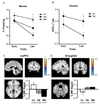The storm and stress of adolescence: insights from human imaging and mouse genetics
- PMID: 20222060
- PMCID: PMC2850961
- DOI: 10.1002/dev.20447
The storm and stress of adolescence: insights from human imaging and mouse genetics
Abstract
The characterization of adolescence as a time of "storm and stress" remains an open debate. Intense and frequent negative affect during this period has been hypothesized to explain the increased rates of affective disorders, suicide, and accidental death during this time of life. Yet some teens emerge from adolescence with minimal turmoil. We provide a neurobiological model of adolescence that proposes an imbalance in the development of subcortical limbic (e.g., amygdala) relative to prefrontal cortical regions as a potential mechanism for heightened emotionality during this period. Empirical support for this model is provided from recent behavioral and human imaging studies on the development of emotion regulation. We then provide examples of environmental factors that may exacerbate imbalances in amygdala-ventrofrontal function increasing risk for anxiety related behaviors. Finally we present data from human and mouse studies to illustrate how genetic factors may enhance or diminish this risk. Together, these studies provide a converging methods approach for understanding the highly variable stress and turmoil experienced in adolescence.
(c) 2010 Wiley Periodicals, Inc.
Figures





References
-
- Abe K, Suzuki T. Prevalence of some symptoms in adolescence and maturity: Social phobias, anxiety symptoms, episodic illusions and ideas of reference. Psychopathology. 1986;19:200–205. - PubMed
-
- Baird AA, Gruber SA, Fein DA, Maas LC, Steingard RJ, Renshaw PF, Cohen BM, Yurgelun-Todd DA. Functional magnetic resonance imaging of facial affect recognition in children and adolescents. Journal of American Academy of Child and Adolescent Psychiatry. 1999;38:195–199. - PubMed
-
- Blakemore S-J. The social brain in adolescence. Nature Reviews Neuroscience. 2008;9:267–277. - PubMed
-
- Blair K, Shaywitz J, Smith BW, Rhodes R, Geraci M, Jones M, McCaffrey D, Vythilingam M, Finger E, Mondillo K, Jacobs M, Charney DS, Blair RJ, Drevets WC, Pine DS. Response to emotional expressions in generalized social phobia and generalized anxiety disorder: evidence for separate disorders. American Journal of Psychiatry. 2008;165:1193–1202. - PMC - PubMed
Publication types
MeSH terms
Grants and funding
LinkOut - more resources
Full Text Sources
Medical

